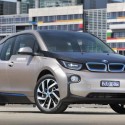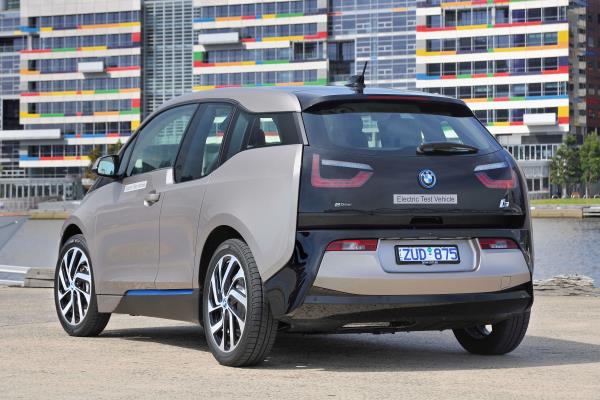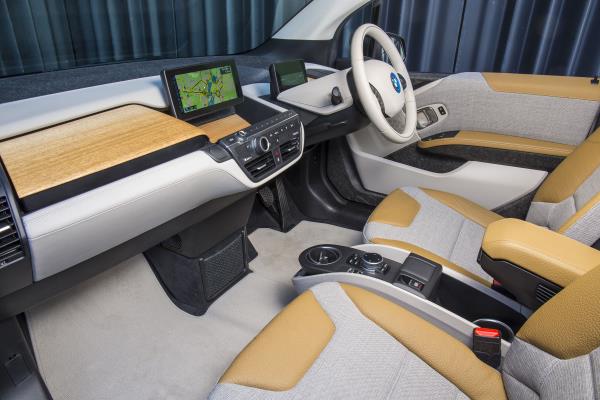By EWAN KENNEDY
The i3 is the start of future motoring according to BMW – a very bold statement that had us initially feeling sceptical, even cynical.
However, the more time we spent at the wheel of the BMW i3 the more we smiled and agreed with BMW’s apparently outrageous prediction.
BMW (under different names) has been in the vanguard of design for almost a century.
It began designing aircraft piston engines in 1916, then very-early jet engines in 1942, before moving into tiny ‘bubble’ cars in the 1950s, finally getting into prestigious mainstream motoring in the 1970s.
That long history of thinking ahead has paved the way for the electric car of the future.
BMW i3 is crammed full of technology, all clothed in a spacious body that weighs just 1195 kg.
The body is made from a combination of carbon-fibre reinforced plastic (CFRP) and aluminium. Note that the optional range-extending petrol engine brings the weight up to 1320kg, a significant difference.
Styling of the BMW i3 puts function before fashion – and we like it like that.
It could be described as boxy, though there are some interesting little touches that disguise the practical shape such as the dummy ‘kidney’ radiator grilles and the truncated rearmost side windows.
Strong body colours, with contrasting hues in the smaller details help reduce the visual bulk.
Interior styling is equally radical.
The dash area has horizontal surfaces, with wood finishes from certified timber suppliers in our test car.
Information is based on the use of tablet style screens that can be set up in a variety of ways.
The BMW i Remote App allows smartphone owners to remotely display information such as range and current battery charge status as well as adjusting the temperature of the interior before entering the car.
There are two monitors located on the dashboard, a small one in front of the driver that shows relevant charging and performance information and a larger (10.3-inch) one in the centre of the dash with the usual multimedia and navigation features.
The BMW i3 is powered only by electricity. A 360-volt electric motor puts out 125 kW of power and 250 Nm of torque, the torque comes on song from just one rpm (that’s right, just one rpm and you’re into maximum grunt!).
This provides more than enough performance for a runabout suburban hatchback.
Zero to 100km in 7.2 seconds in the standard model, and 7.9 seconds in the model with the heavier (by 125kg) Range EXtender (REX) engine.
The latter is a 650cc twin-cylinder petrol unit that charges the batteries.
The petrol engine never powers the i3 directly and only maintains the battery charge at its current level, it doesn’t increase the amount of energy in the batteries, simply increases the overall range of the vehicle.
This is done to encourage drivers to use electrical power as often as possible to reduce exhaust emissions.
Further emphasising this is the fact that the petrol tank contains a mere nine litres.
As in most electric cars there’s no gearbox as such, just a single speed transmission that provides power to the wheels, the rear wheels in the case of the i3.
The biggest plus of electric, and hybrid, vehicles is that energy is put back into the batteries when slowing down or descending a hill.
There are a number of charging options varying from 11 hours for a full charge through a standard domestic 10-amp power point; six hours via a BMW i Wallbox accessory (approximately $1750 plus installation); down to just 30 minutes at a DC fast charging station of which there are currently only two in Melbourne and one in Sydney – with others to come.
We used a standard 10-amp powerpoint in our garage.
This took the best part of 10 hours if the car was fully ‘empty’ but generally only seven to nine hours to give us a decent driving range of 80 to 110 kilometres.
That was using Comfort mode, we also tried Eco Pro and Eco Pro+ modes but found the lack of performance irritating at times as was the lack of air-conditioning in hot and humid Gold Coast weather.
We put ourselves in the keen driver category, presumably green-oriented buyers would get better results, with BMW suggesting 120 to 150km is there if you’re prepared to work at it.
A gentle sound is artificially created at speeds up to 30 km/h to alert pedestrians that an otherwise silent car is in the vicinity.
Crash strength and passenger protection is built into the lightweight composite and aluminium i3 body and it will perform extremely well in collision impacts.
However, because of what BMW says is a technicality in NCAP testing rules the BMW i3 only rates four stars, not the five anticipated.
Performance is terrific, with the instant off-the-line reaction we love in all electric cars.
Zero to 100km/h is achieved in the mid seven second range, that’s small sports hatch territory. Even better is the ability to pick up speed immediately when changing lanes and to overtake on country roads.
There’s near silence from the rear mounted electric motor and the little petrol charging engine is barely audible.
The BMW i3 can be a ‘one-pedal’ car with a little bit of foresight in driving, that is you use the pedal on the right to increase and decrease speed.
We were able to accomplish trips of 20 to 30 kilometres without using the brakes which not only put energy back into the car it also created absolutely no brake dust.
Handling is excellent thanks to the low centre of gravity created by the underfloor batteries.
Road grip through the tall thin tyres is more than enough for most drivers.
On the downside the steering is on the dead side, something that BMW will have to sort out to retain its ‘ultimate driving machine’ ambition.
Interior comfort is generally very good but some Aussie roads that have seen better days, be they in the burbs or the bush, cause the suspension to crash at times.
BMW i3 is taller than the average five-door hatchback because there are banks of batteries under the floor.
Headroom isn’t as generous as you might expect, but is still good. The sunroof does steal a little room, make sure to include the tallest likely travellers as part of your personal road test crew.
There’s very good legroom for four adults. BMW has to be praised for this, as it makes the i3 a genuine day-to-day ‘normal’ car.
The rear-hinged back doors can’t be opened till the fronts are open.
Balancing that out is the ability to get briefcases, shopping and similar stuff very easily into the leg space of the back seat. Surely four conventional doors would make more sense, though.
You sit high, virtually at small crossover SUV height so the view out is better than in sedan or hatch.
The boot is a reasonable size, oddly if you choose an i3 without the range extender you don’t get a bigger boot, presumably the spot not occupied by the petrol engine just sits there vacant.
As well as the rear luggage area, there’s also a 35-litre boot under the front ‘bonnet’.
BMW obviously aims i3 at city and suburban dwellers and we found it extremely usable in these conditions.
It was easy to drive and park, with a tiny turning circle that was a joy in squeezy underground carparks.
At this stage the BMW i3 isn’t cheap, the battery-only model is priced at $63,900 with the range-extender costing an extra $6000.
These are early days and it’s possible that BMW is charging the early adopters top dollar to help recoup R&D costs.
If that’s the case, prices are likely to come down, or at least remain static for quite a while.
Finally a confession.
Most of the time when I return our road test cars after the standard week’s loan I don’t miss them, simply turn my back and walk away.
The futuristic BMW i3 caused me to make a backward glance or two and gave the feeling, “I will miss you little Bimmer, pity I can’t keep you a lot longer…”
Model range
i3 pure-electric five-door hatch: $63,900
i3 Range Extender petrol /electric five-door hatch: $66,900










